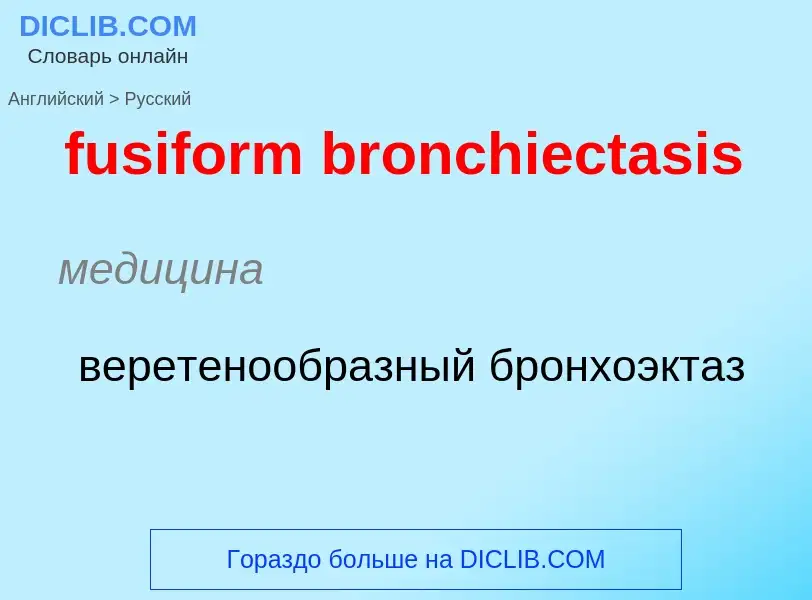Перевод и анализ слов искусственным интеллектом ChatGPT
На этой странице Вы можете получить подробный анализ слова или словосочетания, произведенный с помощью лучшей на сегодняшний день технологии искусственного интеллекта:
- как употребляется слово
- частота употребления
- используется оно чаще в устной или письменной речи
- варианты перевода слова
- примеры употребления (несколько фраз с переводом)
- этимология
fusiform bronchiectasis - перевод на русский
медицина
веретенообразный бронхоэктаз
[brɔŋki'ektəsis]
медицина
бронхоэктазия
расширение бронхов
бронхоэктаз
существительное
медицина
бронхоэктазия
расширение бронхов
медицина
веретеновидная клетка
Определение
Википедия

Bronchiectasis is a disease in which there is permanent enlargement of parts of the airways of the lung. Symptoms typically include a chronic cough with mucus production. Other symptoms include shortness of breath, coughing up blood, and chest pain. Wheezing and nail clubbing may also occur. Those with the disease often get lung infections.
Bronchiectasis may result from a number of infectious and acquired causes, including measles, pneumonia, tuberculosis, immune system problems, as well as the genetic disorder cystic fibrosis. Cystic fibrosis eventually results in severe bronchiectasis in nearly all cases. The cause in 10–50% of those without cystic fibrosis is unknown. The mechanism of disease is breakdown of the airways due to an excessive inflammatory response. Involved airways (bronchi) become enlarged and thus less able to clear secretions. These secretions increase the amount of bacteria in the lungs, resulting in airway blockage and further breakdown of the airways. It is classified as an obstructive lung disease, along with chronic obstructive pulmonary disease and asthma. The diagnosis is suspected based on symptoms and confirmed using computed tomography. Cultures of the mucus produced may be useful to determine treatment in those who have acute worsening and at least once a year.
Periods of worsening may occur due to infection. In these cases, antibiotics are recommended. Common antibiotics used include amoxicillin, erythromycin, or doxycycline. Antibiotics, such as erythromycin, may also be used to prevent worsening of disease. Airway clearance techniques, a type of physical therapy, are also recommended. Medications to dilate the airways and inhaled steroids may be used during sudden worsening, but there are no studies to determine effectiveness. There are also no studies on the use of inhaled steroids in children. Surgery, while commonly done, has not been well studied. Lung transplantation may be an option in those with very severe disease.
The disease affects between 1 per 1000 and 1 per 250,000 adults. The disease is more common in women and increases as people age. It became less common since the 1950s with the introduction of antibiotics. It is more common among certain ethnic groups (such as indigenous people in the US). It was first described by René Laennec in 1819. The economic costs in the United States are estimated at $630 million per year.



![[[CT scan]] of the lungs showing findings diagnostic of bronchiectasis. White and black arrows point to dilated bronchi characteristic of the disease. [[CT scan]] of the lungs showing findings diagnostic of bronchiectasis. White and black arrows point to dilated bronchi characteristic of the disease.](https://commons.wikimedia.org/wiki/Special:FilePath/Bronquiectasia.jpeg?width=200)

![[[Azithromycin]] is a [[macrolide]] commonly used in bronchiectasis. [[Azithromycin]] is a [[macrolide]] commonly used in bronchiectasis.](https://commons.wikimedia.org/wiki/Special:FilePath/Zithromax (Azithromycin) tablets.jpg?width=200)
![Bronchiectasis primarily in the [[middle lobe]] of the right lung. Bronchiectasis primarily in the [[middle lobe]] of the right lung.](https://commons.wikimedia.org/wiki/Special:FilePath/Bronchiectasis (3705143327).jpg?width=200)






